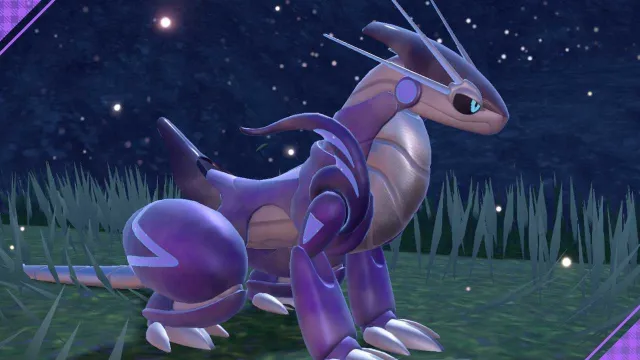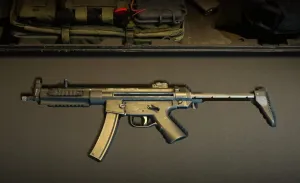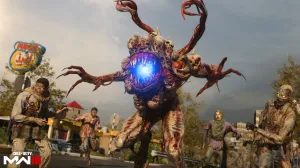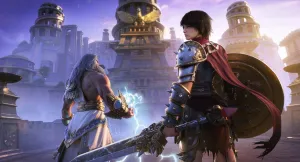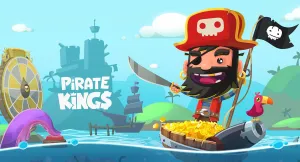Nicolas Estrup, the Vice President of Product for BLAST, one of Counter-Strike: Global Offensive’s biggest tournament organizers, looked on in horror as FaZe Clan were lifted onto the BLAST Premier: Fall Final stage via a hydraulic lift. Only four heads crested the stage. It seemed as though someone had missed their entrance.
After a painfully long moment, it became clear that the last player, Finn “karrigan” Andersen, was there. He was just kneeling. A moment later, karrigan stood and revealed that he was wearing a batman mask, which matched the batman logo on FaZe’s new jerseys. He struck a pose, puffing out his chest.
Estrup breathed a sigh of relief. The intro was still running smoothly, and what seemed like a gaffe quickly became one of the best moments of the show.
The Dark Knight rises at BLAST
Estrup organizes the BLAST Premier tournament series, which culminates in the yearly BLAST World Final. The tournament begins soon, running from Tuesday through Sunday, Dec. 19. Unfortunately, it will not feature a live audience — as COVID-19 counts in Europe are still on the rise — but Estrup is confident that his team will deliver a satisfying studio event for pros and fans alike and build on the organizer’s success at the BLAST Fall Final.
The Fall Final marked a return to an in-arena event with a live audience, following on the heels of the PGL Stockholm Major 2021, the first arena event since before the COVID-19 pandemic. As the VP of product, Estrup was responsible for turning the tournament into a spectacle.
Karrigan’s entrance became a highlight of the BLAST Fall Final. A Dane in front of a Danish crowd, karrigan leaned into the role of an entertainer, playing up his Batman persona for the audience.

The BLAST production team were quick to jump on the opportunity.
A combined effort from BLAST’s in-game, social and graphics team led to a rapid, last-minute update to the heads-up display, replacing karrigan’s normal player profile picture with his new Batman persona. Bat-karrigan moved about on the mini-map, doling out death with assault rifles to Terrorists and Counter-Terrorists in very un-Batman fashion.
“When you have the fundamentals in place,” Estrup said of the team’s quick adaptation, “you can begin having fun with it.”
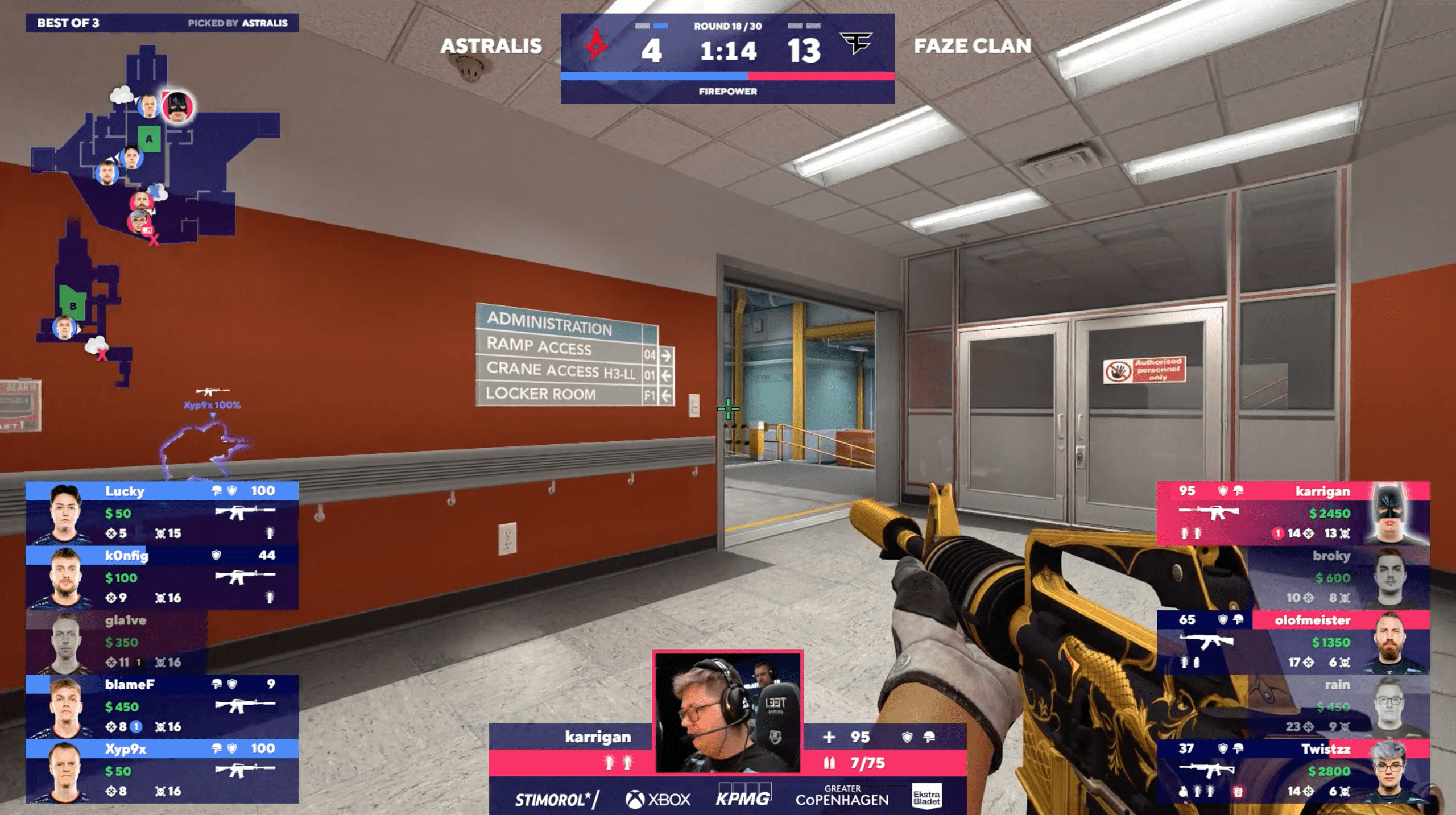
These “cherry-on-top” moments were nice complements to the basics of event production that Estrup and his team at BLAST have tried to perfect — from clear audio to smooth stream transitions and everything in between. The Fall Final was a maelstrom of planning and logistics for Estrup’s team, ultimately coming to a head as Natus Vincere were crowned the victors and hoisted the trophy.
The weird and the wonderful
On Dec. 1, Estrup celebrated his five-year anniversary with BLAST. He’s been in the esports space for a lot longer.
“I have no education,” Estrup said. “I’ve just been in esports since the early days. I’m from a small group of friends in Denmark with people like [Danny “zonic” Sørensen], the former coach of Astralis.”
Estrup said that, at some point, he realized he just wasn’t as good at games as his peers. He knew that to stay in esports and make a career out of what he loved, he’d have to shift his focus. For over 15 years, he’s worked on everything from corporate content, commercials, sports documentaries and esports content. He learned how to film, shoot, edit and produce. And, at the end of it all, he brought his passion for esports entertainment to BLAST.
Estrup spoke about his job with evident enthusiasm, recalling all the weird and wonderful aspects of putting together an event; not least of which was his recollection of a very odd incident at the Fall Final where one team kept asking about the weight limit on the hydraulic lifts. Estrup pressed them to know why, but they wouldn’t tell him until right before their match.
“‘It’s because we have this baby elephant,’” Estrup said, “‘and we want to try and see if we could bring a live baby elephant up on the stage.’ And I was like, ‘What? Are you being serious right now?’”
Unsure whether or not they were joking, Estrup quite sensibly refused to let them bring a baby elephant into an arena filled with thousands of fans.
“So I guess the big question mark is, was there ever really a baby elephant?” Estrup said.

Behind the curtain at BLAST Fall
The BLAST team had more than two years to contemplate their return to in-arena events. Then came the PGL Major. As close as the event was to the BLAST Fall Final, nothing Estrup and his team did was a reaction to PGL’s efforts. There was simply no time to adjust the planning, even if something they saw at the major made them want to change things on their own end.
“I think they did a great show, but we felt very comfortable with what we followed up with,” Estrup said. “It’s almost like a poker game. They sit over there, they throw their cards on the table and then you hope your cards are better when you throw yours down.”
Most tournament organizers are aware of what others are doing in the space between going to other events and generally keeping an eye on things, but they aren’t necessarily pitting themselves against one another. Estrup’s vision of BLAST is more ambitious, looking at traditional in-arena entertainment, such as sports and concerts, as the gold standard for what esports events can be.
“It’s a bit of a music festival, concert meets an esports show and a traditional sports broadcast,” Estrup said. “We’ve thrown all that into one big soup. We feel like that’s what makes it magical.”
That vision showed in the makeup of the BLAST Fall Final crowd, where families with young kids were in attendance; a stark contrast to the assumption of predominately young, male esports crowds. Not all of the credit goes to BLAST, as the event’s success was also due in part to Astralis and what the organization has done in Copenhagen to build the Astralis brand into a household name.

Of course, there are still some drawbacks to this more accessible version of CS:GO. A substantial portion of the crowd were fans of Astralis rather than Counter-Strike. This showed in the diminished attendance once Astralis were knocked out of the Fall Final.
With the BLAST Fall Final, CS:GO fans also got a fresh reminder about some of the potential pitfalls of in-arena events.
“When you have a very one-sided fan group, that’s when you just have to switch up to a slightly higher gear on being aware,” Estrup said. “We’ve gone out on stage and said, ‘If you don’t stop yelling where the other team is going, we’ll just turn off the screens.’”
In the past, BLAST had turned off the X-ray silhouettes on the HUD that indicate where the other team’s players are. One other fix to these endemic cheating issues that arise with large crowds is soundproof booths, which Estrup wants to avoid at all costs.
“Fundamentally, we’re struggling with putting players inside a box because so much of that arena experience comes from teams feeding off fans and fans feeding off teams,” Estrup said. “We’re much more keen on figuring out the best audio setup we can do to make sure we can minimize all the things we want to avoid.”
As a fan of the in-arena esports experience, Estrup said he feels strongly that the intimate relationship between fans and the players must be preserved at all costs. That mentality was clearly on display in the Fall Final, where the stage’s design promoted interaction between the two groups.
Tournament organizers: The good, the bad and the ugly
David “prius” Kuntz, one of the most experienced observers in CS:GO and someone who’s worked on almost all BLAST events, has had largely favorable experiences with tournament organizers, the one caveat being that they rarely do enough to credit their observers as part of the talent.
“Anything I want to do in-game, they fully support it,” prius said. “All the staff/contractors that work the BLAST events are also very fun to be around, and I genuinely enjoy being there.”
A veteran within the space, prius has been observing, meaning controlling an in-game camera for esports broadcasts, for years. He’s worked with a number of different tournament organizers, including Riot Games, ESL and, of course, BLAST, but has a special fondness for BeyondTheSummit.

If BLAST’s specialty is the in-arena experience and live entertainment, then BTS’s specialty is the homey and authentic feeling of having “back-stage access” to the pros. The close-quarters environment of their Los Angeles studio and the feeling of closeness characterize their productions.
“The chill environment with players, talent and staff in a studio/house was fantastic. Also, hearing the players’ personalities come alive on the couch along with the other talent was fun to be a part of,” prius said. “And don’t get me started about their catering — the best of the best of any event.”
Most tournament organizers are well-established in their respective games. In some cases, though, you get rising stars carving out their own niche. WePlay Esports, based out of Kiev, Ukraine, is still in its infancy. Their second season of the WePlay Academy League drew a lot of praise, shining a spotlight on some of the best up-and-coming talent in CS:GO.
Then there’s ESL, the behemoth of CS:GO tournament organizers. Its events account for the substantial majority of Tier 1 tournaments each year, including mainstays of the esport like IEM Katowice and IEM Cologne.
And finally, there’s BLAST, who fill in the seams between the ESL tournaments and the Valve-sponsored majors. Outside of the Fall Final, BLAST have been largely hampered by the COVID-19 restrictions, unable to provide the arena experience that Estrup said is the tournament organizer’s greatest strength. Like countless other CS:GO fans, he hopes for a return to more consistent arena events in 2022.
One thing is certain: Estrup will keep pushing the esports experience and his staff at BLAST.
“Yes, I’m an old-school esports guy, but I have no problem challenging the heritage of what that means,” Estrup said. “That’s one of the things that I’m allergic to hearing: ‘It’s the norm. It’s what we’ve always done.’ OK, great. Then we definitely need to try and throw a hand grenade into that and see what happens.”
